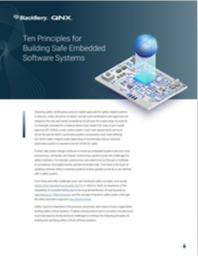Ten Principles for Building Safe Embedded Software Systems
Obtaining safety certifications and pre-market approvals for safety-related systems is arduous, costly, and prone to failure. And yet such certifications and approvals are integral to the sale and market acceptance of software for a wide range of products.
Further, safe system design continues to evolve as embedded systems become more autonomous, connected, and shared. Autonomous systems pose new challenges for safety engineers.
For example, autonomous cars need to be run through a multitude of simulations, thoroughly trained, and demonstrated safe. Then there is the issue of updating software: When connected systems receive updates on the fly, it can interfere with a safety system. And shared systems risk interference from other software.
Safety must be embedded in the practices, processes, and culture of every organization building safety-critical systems. If safety-critical products are to succeed, manufacturers must look beyond strictly technical challenges to embrace the principles mentioned in this Whitepaper for building and certifying safety-critical software systems.
Read More
By submitting this form you agree to BlackBerry QNX contacting you with marketing-related emails or by telephone. You may unsubscribe at any time. BlackBerry QNX web sites and communications are subject to their Privacy Notice.
By requesting this resource you agree to our terms of use. All data is protected by our Privacy Notice. If you have any further questions please email dataprotection@techpublishhub.com
Related Categories: Automotive, Components, Embedded, Industrial, Power


More resources from BlackBerry QNX

Ultimate Guide to Functional Safety and Safety Certification
Functional safety actively prevents the failure of a system from causing harm to people and property. Developers often need to certify a system as ...

5 Reasons to Consider an Alternative to Linux for Your Medical Device
Medical device designers have become increasingly interested in the Linux® operating system (OS), largely because of its open source model. Linux ...

Accelerate Innovation: How Adopting a Scalable Platform Architecture can Speed Product Development
The pace of innovation has changed. Original equipment manufacturers (OEMs) can no longer take years to introduce new products or update functional...

